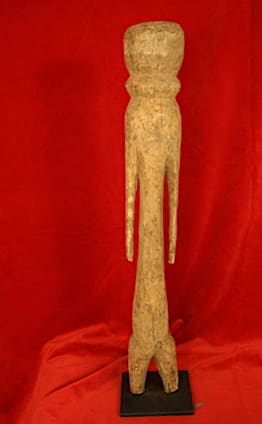Moba Tchitchiri Sculpture, 20th Century CE
wood
PF.4848 (LSO)
Further images
This monolithic sculpture of a standing human figure was made by the Moba people of Ghana and Togo. Despite being closely allied with the Asante in economic and social terms,...
This monolithic sculpture of a standing human figure was made by the Moba people of Ghana and Togo. Despite being closely allied with the Asante in economic and social terms, their artworks are – as can be seen – highly distinctive. This particular piece is a classical example of the genre, with tiny legs, a very long torso, broad shoulders producing spindly arms, a ring around the approximate location of the neck, and a rounded block-shaped head without any facial features.
Tchitcheri (singular: tchicherik) sculptures are carved by diviners in order to be placed on domestic shrines. They represent the embodiment of household spirits and guardians, and are revered with libations. Very large versions (tchitcheri sakab) are buried up to their waists in fields, and decorated with agrarian artefacts; these are designed to represent the founding members of the various Moba clans. They are associated with “earth shrines” named tingban, which are serviced by various important families.
This piece is a perfect example of the effortlessness with which African artists are able to deconstruct the human figure to the required elements, and illustrates why their creations had such an impact on European art movements in the 20th century. This is a striking and confident piece of socially-significant African art that would be at home in any collection or sophisticated domestic setting.
Tchitcheri (singular: tchicherik) sculptures are carved by diviners in order to be placed on domestic shrines. They represent the embodiment of household spirits and guardians, and are revered with libations. Very large versions (tchitcheri sakab) are buried up to their waists in fields, and decorated with agrarian artefacts; these are designed to represent the founding members of the various Moba clans. They are associated with “earth shrines” named tingban, which are serviced by various important families.
This piece is a perfect example of the effortlessness with which African artists are able to deconstruct the human figure to the required elements, and illustrates why their creations had such an impact on European art movements in the 20th century. This is a striking and confident piece of socially-significant African art that would be at home in any collection or sophisticated domestic setting.





